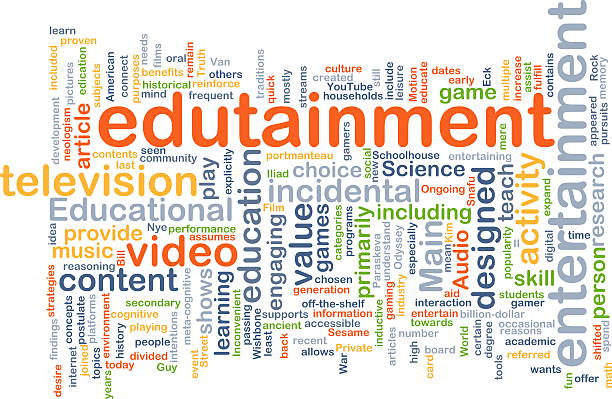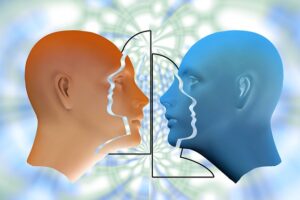Edutainment, Learning, Play, Education and Entertainment

1. Sesame Street to Netflix, A Brief History of Edutainment
- The rise of educational video games: In the 1980s and 1990s, educational video games became increasingly popular, with titles such as “Oregon Trail” and “Where in the World is Carmen Sandiego?” teaching players about history, geography, and problem-solving.
- The impact of the Internet: With the advent of the Internet, edutainment became more accessible than ever before. Websites such as Brain POP and Khan Academy provided learners with a wealth of educational resources, while online games and interactive videos made learning fun and engaging.
- The emergence of edutainment streaming services: In recent years, streaming services such as Netflix and Amazon Prime Video have begun to incorporate edutainment into their programming, with shows such as “Bill Nye Saves the World” and “The Magic School Bus Rides Again” teaching viewers about science, technology, engineering, and math (STEM) entertainingly and engagingly.
- The future of edutainment: As technology continues to advance, the possibilities for edutainment are endless. Virtual reality, augmented reality, and other immersive technologies are already being used to create interactive educational experiences, while artificial intelligence and machine learning have the potential to personalize learning and make it more effective than ever before.
From the early days of television to the rise of streaming services, edutainment has come a long way. With its unique combination of education and entertainment, edutainment has proven to be a powerful tool for engaging learners and promoting lifelong learning. As technology continues to evolve, the future of edutainment looks bright, with endless possibilities for creating innovative and effective learning experiences.
2. Introduction to Edutainment
Edutainment Explained
Edutainment is a term that combines education and entertainment and refers to any form of media or content that aims to teach or inform while also being engaging and entertaining. Examples of edutainment content can include TV shows, video games, mobile apps, interactive exhibits, and educational websites. The goal of edutainment is to make learning more enjoyable and accessible, by capturing people’s attention and imagination through fun and interactive experiences.

Edutainment has been around for decades, but it has gained increasing prominence in recent years, as technology has made it easier to create and distribute high-quality edutainment content. One of the key benefits of edutainment is that it can make learning more engaging and effective. By presenting information in a fun and interactive way, edutainment can help learners retain knowledge and develop a deeper understanding of complex topics.
Another benefit of edutainment is that it can be tailored to suit different learning styles and preferences. Some people may learn best through visual or interactive content, while others may prefer audio or text-based formats. Edutainment can be designed to cater to a wide range of preferences, making it accessible to learners of all ages and backgrounds.
Overall, edutainment has the potential to revolutionize the way we approach education, by making learning more enjoyable, effective, and accessible. Whether you’re a student, a professional, or just someone who enjoys learning new things, edutainment can offer a fun and engaging way to expand your knowledge and skills.
3. Origin of the Word Edutainment
The word “edutainment” is a combination of the words “education” and “entertainment”. The term was coined in the 1940s by the American media theorist Marshall McLuhan, who used it to describe the merging of education and entertainment in the mass media. The term gained popularity in the 1980s, particularly with the rise of educational video games, and has since been used to describe any form of media that combines education and entertainment, such as television shows, movies, and online content.
4. The Surprising Benefits of Edutainment, How Learning Can Be Fun
Introduction: When we think of education, many of us may picture a dry, boring lecture or a tedious textbook. But what if learning could be fun? That’s the promise of edutainment, a term that combines education and entertainment. In this post, we’ll explore the surprising benefits of edutainment and explain why learning can be a lot more enjoyable than you might think.
- Edutainment is engaging: One of the biggest advantages of edutainment is that it’s inherently engaging. By combining education and entertainment, edutainment captures our attention and holds it. Whether it’s a game, a video, or a TV show, edutainment has the power to make learning fun and memorable.
-

Smiling children playing musical instruments at home. sisters have fun in the room - Edutainment is effective: But edutainment isn’t just fun; it’s also effective. Studies have shown that edutainment can be an effective way to teach a wide range of subjects, from science to history to math. By engaging learners and making the material more memorable, edutainment can help people retain information and improve their understanding of complex topics.
- Edutainment is accessible: Another benefit of edutainment is that it’s often more accessible than traditional educational materials. With the rise of online platforms and mobile devices, edutainment content is more widely available than ever before. This means that learners can access edutainment content on their own schedule, from virtually anywhere in the world.
- Edutainment is adaptable: Finally, edutainment is adaptable. Whether you’re a child or an adult, a visual learner or an auditory learner, there’s an edutainment format that’s likely to appeal to you. From interactive games to immersive simulations, edutainment can be tailored to suit a wide range of learning styles and preferences.
To conclude, edutainment offers a wealth of benefits for learners of all ages and backgrounds. By making learning more engaging, effective, accessible, and adaptable, edutainment has the potential to revolutionize the way we approach education. So the next time you’re looking to learn something new, consider exploring the world of edutainment. You might be surprised by how much fun you have along the way.
5. Difference between Entertainment and Edutainment
Entertainment and edutainment share many similarities, but the key difference between them lies in their primary purpose.
Entertainment is primarily focused on providing enjoyment and pleasure to the audience. It may be in the form of movies, TV shows, music, games, sports, or any other activity that people do to relax and have fun. While entertainment can be informative, its primary goal is to entertain and engage the audience.
Edutainment, on the other hand, is focused on educating the audience while also entertaining them. It is designed to be a fun and engaging way to learn new things or reinforce existing knowledge. Edutainment can take many forms, including educational games, interactive videos, museum exhibits, and TV shows. Its primary goal is to educate the audience, while also making the learning experience enjoyable and memorable.
In summary, while entertainment aims to provide enjoyment, edutainment aims to educate while also entertaining.
6. The Basic Concepts used in Education
Education is a complex field that incorporates a variety of concepts and theories. Here are some of the basic concepts used in education:
- Learning: This refers to the process of acquiring knowledge, skills, and understanding through study, experience, or teaching.
- Curriculum: This refers to the set of courses, activities, and materials that make up a particular educational program.
- Instruction: This refers to the methods and techniques used to teach or convey information to learners.
- Assessment: This refers to the process of evaluating the knowledge, skills, and understanding of learners.
- Pedagogy: This refers to the theory and practice of teaching, including the strategies and techniques used to facilitate learning.
- Differentiation: This refers to the practice of tailoring instruction to meet the diverse needs of learners, including those with different learning styles, abilities, and backgrounds.
- Classroom management: This refers to the techniques and strategies used to create a positive and effective learning environment in the classroom.
- Motivation: This refers to the factors that drive and sustain learners’ interest and engagement in the learning process.
- Feedback: This refers to the information provided to learners about their performance, progress, and areas for improvement.
- Bloom’s Taxonomy: This is a framework that categorizes learning objectives into different levels of complexity, from lower-order thinking skills such as remembering and understanding, to higher-order thinking skills such as analyzing and evaluating.
7. Ways to Incorporate Edutainment into Your Daily Routine
Incorporating edutainment into your daily routine can be a fun and effective way to learn new things and expand your knowledge. Whether you’re looking to improve your skills, explore a new hobby, or simply stay entertained while you learn, there are plenty of ways to incorporate edutainment into your daily life. In this post, we’ll share 5 simple and practical ways to make edutainment a part of your daily routine.
- Listen to educational podcasts on your commute: If you have a long commute to work or school, listening to educational podcasts can be a great way to make use of that time. There are plenty of podcasts available on a wide range of topics, from science and history to politics and business. Simply download a few episodes and listen to them during your commute to turn your idle time into a learning opportunity.
- Play educational games on your phone or tablet: If you enjoy playing games on your phone or tablet, why not try some educational games? There are plenty of apps available that can help you learn new skills or expand your knowledge, from language-learning apps to puzzle games that challenge your critical thinking skills. Try downloading a few and see which ones you enjoy the most.
- Watch educational videos on YouTube: YouTube is home to a vast array of educational content, from science experiments and history documentaries to language lessons and how-to tutorials. Whether you’re looking to learn something new or just want to be entertained while you learn, there’s sure to be something on YouTube that interests you. You can even subscribe to channels that specialize in edutainment content to make sure you never run out of things to watch.
- Attend virtual events or workshops: Many organizations offer virtual events or workshops that can be attended from the comfort of your own home. Whether it’s a webinar on a topic that interests you or a virtual cooking class, these events can be a fun and engaging way to learn new skills or explore new hobbies. Check out websites like Eventbrite or Meetup to find virtual events in your area.
- Read edutainment books or articles: Finally, reading edutainment books or articles can be a great way to incorporate learning into your daily routine. Whether you prefer fiction or non-fiction, there are plenty of books available that can teach you something new while also entertaining you. Alternatively, you can read articles on websites like Medium or Brain Pickings, which offer a wide range of interesting and informative content.
Incorporating edutainment into your daily routine doesn’t have to be difficult or time-consuming. By trying out these 5 simple and practical ways to make edutainment a part of your daily life, you can learn new things and expand your knowledge while also having fun and staying entertained. So why not give them a try and see how edutainment can enhance your daily routine?
8. The Future of Edutainment: What’s Next for Learning and Entertainment?
Introduction: Edutainment has come a long way in recent years, with advancements in technology enabling new and innovative ways to combine learning and entertainment. From virtual reality experiences to gamified learning platforms, edutainment has the potential to revolutionize the way we approach education. In this post, we’ll explore the future of edutainment and what we can expect in the years to come.
- Virtual and augmented reality: Virtual and augmented reality technologies are already being used to create immersive edutainment experiences, such as virtual field trips or interactive science experiments. In the future, we can expect these technologies to become more accessible and affordable, allowing for even more engaging and interactive learning experiences.
- Personalized learning: As technology continues to advance, personalized learning platforms will become more sophisticated and effective. These platforms will use data and analytics to create personalized learning paths for each individual learner, based on their interests, learning style, and performance.
- Gamification: Gamification has already proven to be an effective way to engage learners and make learning more fun. In the future, we can expect to see even more gamified learning platforms and experiences, incorporating elements such as rewards, competition, and social interaction to keep learners motivated and engaged.
- Artificial intelligence: Artificial intelligence has the potential to revolutionize edutainment, by providing personalized feedback and support to learners in real-time. AI-powered chatbots and virtual assistants can help learners with everything from answering questions to providing guidance and support throughout the learning process.
- Collaborative learning: Collaborative learning experiences, such as group projects or peer-to-peer learning, can be a valuable way to enhance learning outcomes and promote social interaction. In the future, we can expect to see more edutainment platforms and experiences that incorporate collaborative learning, allowing learners to work together and learn from one another.
The future of edutainment is exciting and full of possibilities. As technology continues to advance, we can expect to see even more innovative and engaging ways to combine learning and entertainment. Whether it’s through virtual reality experiences, personalized learning platforms, or gamified learning experiences, the future of edutainment is sure to provide new and exciting opportunities for learners of all ages and backgrounds.
9. The Science of Edutainment, Why Our Brains Love to Learn through Play
Edutainment has become an increasingly popular way to learn, combining education with entertainment to create a fun and engaging learning experience. But why is edutainment so effective? In this post, we’ll explore the science behind edutainment and why our brains love to learn through play.

- The dopamine reward system: When we engage in activities that we enjoy, our brains release dopamine, a neurotransmitter that is associated with pleasure and reward. Edutainment can activate this reward system by incorporating elements such as gamification, competition, and feedback, making the learning experience more enjoyable and motivating.
- The power of storytelling: Humans have been using storytelling to transmit knowledge and information for thousands of years. By incorporating storytelling into edutainment, we can tap into our natural curiosity and desire to learn through narrative and make learning more engaging and memorable.
- Active learning vs. passive learning: Active learning, which involves actively engaging with the material through activities such as discussion, problem-solving, or hands-on experimentation, has been shown to be more effective than passive learning, which involves simply listening or reading. Edutainment can facilitate active learning by providing opportunities for learners to interact with the material in a fun and engaging way.
- The role of emotions in learning: Emotions play a crucial role in learning, as they can impact our motivation, attention, and memory. Edutainment can tap into emotions by creating an engaging and immersive learning environment that stimulates curiosity, excitement, and a sense of accomplishment.
- The impact of novelty: Our brains are wired to seek out novelty and new experiences. Edutainment can provide learners with new and exciting ways to engage with the material, making the learning experience more memorable and enjoyable.
The science behind edutainment is clear: our brains love to learn through play. By incorporating elements such as gamification, storytelling, active learning, emotions, and novelty, edutainment can create a fun and engaging learning experience that is effective and memorable. Whether you’re a student, a professional, or simply someone who loves to learn, edutainment can provide a unique and enjoyable way to acquire new knowledge and skills.
10. Countries Practicing Edutainment as a Way of Education
While edutainment has been used informally in many countries, few countries have formally adopted edutainment as a way of education.
One notable example is South Korea, where the government has embraced edutainment as a way to engage students and enhance learning outcomes. In South Korea, there are government-funded edutainment centers and programs that use technology and interactive media to make learning more engaging and fun.
In the United States, edutainment has been widely used in informal education, such as museums and science centers. However, it is not yet widely adopted as a formal way of education in schools.
Other countries, such as Finland, have integrated elements of edutainment into their education system, but they do not explicitly refer to it as edutainment.
Overall, while some countries have incorporated edutainment into their education systems, it is not yet a widely adopted approach to formal education on a global scale.


